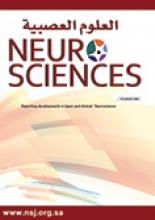Article Figures & Data
Tables
Characteristics Structural Genetic Infectious Metabolic Immune Unknown Total number Total number 41 (27.3) 43 (28.7) 8 (5.3) 10 (6.7) 1 (0.7) 47 (31.3) 150 Gender distribution Male 23 (56.1) 17 (39.5) 4 (50.0) 6 (60.0) 0 18 (38.3) 68 (45.3) Female 18 (43.9) 26 (60.5) 4 (50.0) 4 (40.0) 1 (100.0) 29 (61.7) 82 (54.7) Age at onset (first seizure) 0-7 days 4 (9.8) 8 (18.6) 0 1 (10.0) 0 4 (8.5) 17 (11.3) 8-30 days 14 (34.1) 6 (14.0) 2 (25.0) 0 0 4 (8.5) 26 (17.3) 1-24 months 23 (56.1) 29 (67.4) 6 (75.0) 9 (90.0) 1 (100.0) 39 (83.0) 107 (71.3) Seizure type Focal 13 (31.7) 7 (16.3) 3 (37.5) 2 (20.0) 1 (100.0) 7 (14.9) 33 (22.0) Generalized 28 (68.3) 36 (83.7) 5 (62.5) 8 (80.0) 0 40 (85.1) 117 (78.0) Generalized type Atonic 0 1 (2.3) 0 1 (10.0) 0 4 (8.5) 6 (4) Clonic 1 (2.4) 0 0 0 0 0 1 (0.67) Infantile spasm 3 (7.3) 9 (20.9) 0 1 (10.0) 0 6 (12.8) 19 (13) Myoclonic 1 (2.4) 1 (2.3) 0 0 0 2 (4.3) 4 (2.7) Tonic 11 (26.8) 8 (18.6) 1 (12.5) 2 (20.0) 0 9 (19.1) 31(21) Tonic clonic 12 (29.3) 17 (39.5) 4 (50.0) 4 (40.0) 0 19 (40.4) 56 (37) History of febrile convulsion 2 (4.9) 0 0 0 0 4 (8.5) 6 (4.0) Family history Epilepsy 6 (14.6) 15 (34.9) 0 4 (40.0) 0 13 (27.7) 38 (25.3) Global developmental delay 31 (75.6) 33 (76.7) 5 (62.5) 8 (80.0) 0 18 (38.3) 95 (63.3) Pyramidal signs 19 (46.3) 8 (18.6) 2 (25.0) 3 (30.0) 0 3 (6.3) 35 (23.3) Hypotonia 13 (31.7) 22 (51.2) 1 (14.3) 4 (40.0) 0 11 (23.4) 51(34.0) Dysmorphic features 4 (9.8) 10 (23.3) 0 1 (10.0) 0 4 (8.5) 19 (12.6) abnormal head circumference 10 (24.3) 5 (11.6) 0 2 (20.0) 0 1 (2.1) 18 (12) Abnormal Neuroimaging CT scan 4 (9.8) 1 (2.3) 2 (25.0) 1 (10.0) 0 1 (2.1) 96 (64) MRI scan 36 (87.8) 23 (53.5) 6 (75.0) 7 (70.0) 1 (100.0) 14 (29.8) Abnormal EEG finding 26 (63.4) 21(49) 6 (75) 6 (60) 1 (100.0) 22 (47) 82 (54.7) EEG -Electroencephalography, CT - computed tomography, MRI - Magnetic resonance imaging
- Table 2
- Metabolic and genetic causes among 150 children with epilepsy below 2 years of age.
Metabolic causes (total No. 10 (6.7%)) Aminoacylase deficiency (ACY1)
Congenital Methemoglobinemia (CYB5R3), G6PD Deficiency
Malonic acidemia (MAL)
Hemizygous pathogenic variant in G6PD gene
Succinic semialdehyde dehydrogenase (SSADH) deficiency (ALDH5A1)
Pyridoxal 5 phosphate dependent epilepsy (PNPO)
Biotinidase deficiency
Rhizomelic chondrodysplasia punctate type 2 (GNPAT)
Sanfilippo A (MPS3A)
Sulfite Oxidase deficiency (SUOX)
Genetic causes (total No. 43 (28.7%)) SCN1A-related seizure disorder
Dravet syndrome (SCN1A)
Benign familial Neonatal convulsion (KCNQ2)
Early Infantile Epileptic Encephalopathy (SCN2A)
Early Infantile Epileptic Encephalopathy type 7 (KCNQ2)
Early Infantile Epileptic Encephalopathy type 9 (PCDH19)
Early Infantile Epileptic Encephalopathy type 11 (SCN2A)
Early infantile Epileptic Encephalopathy Type 14 (KCNT1)
Early Infantile Epileptic Encephalopathy type 18 (SZT2)
Early infantile Epileptic Encephalopathy type 25 (SLC13A5)
Early Infantile Epileptic Encephalopathy type 35 (ITPA)
Earli Infantile Epileptic Encephalopathy type 49 (DENND5A)
Early Infantile Epileptic Encephalopathy type 66 (PACS2)
GLUT1 deficiency (SLC2A1)
Infantile spasm (CACNB4)
Epileptic encephalopathy, brain malformation (EML1)
Autosomal Recessive Neurodevelopmental disorder with microcephaly, cataract and renal abnormalities (GEMIN4)
GEMIN4- related phenotype with global developmental delay and congenital cataract
Pseudo-TORCH syndrome (USP18)
Epilepsy, progressive myoclonic (NHLRC1)
Autosomal dominant Wiedemann-Steiner syndrome (KMT2A)
X-linked epilepsy with variable learning disabilities and behavior disorders (SYN1)
Autosomal recessive microcephaly, seizers, and developmental delay (MCSZ) (PNKP)
Autosomal recessive spinocerebellar ataxia type 20 (SNX14)
Ischemic stroke secondary to heterozygous G20210A factor II prothrombin mutation in F2 gene
Tuberous Sclerosis Complex (TSC2)
Sturge-Weber syndrome.
Rett syndrome (FOXG1)
Down Syndrome and Epileptic Encephalopathy (Infantile spasm)
Galloway-Mowat syndrome (WDR73)
Joubert syndrome (CC2D2A)
Aicardi Goutieres syndrome (type AGS- 3
Cause n (%) Perinatal insult 25 /41 (60.9%) Congenital 11/41 (26.8%) Chiari malformation II (2 patients)
Chiari II malformation with bilateral subependymal gray matter heterotopia.
Dandy walker variants.
Arteriovenous malformation (AVM) (2 patients)
Large cisterna magna communicating with the 4th ventricle.
Left frontal insular cortical dysplasia
Extensive cerebral white matter cystic changes.
Severe cerebral malformation with pachygyria.
Extensive polymicrogyria.
Traumatic Massive parenchymal, subarachnoid, and intraventricular hemorrhage with small subdural hematoma.
Bilateral subdural hematoma.
Concussion / fracture (2 patients)
4/41 (9.8%) Brain tumor Pilocytic astrocytoma
1 /41 (2.4%)






